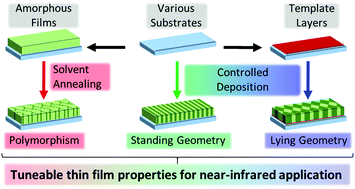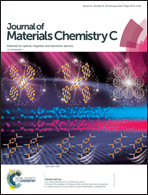Controlling the crystallinity and crystalline orientation of “shuttlecock” naphthalocyanine films for near-infrared optoelectronic applications†
Abstract
The thin film properties of tin(II) 2,3-naphthalocyanine (SnNPc) were interrogated and various strategies for controlling the crystallinity and crystalline orientation within the films were assessed. SnNPc is shown to crystallize in the space group P21/c (Z = 4), where the molecular arrangement consists of alternating layers of concave and convex overlap, induced by the out-of-plane Sn atoms, resulting in a 3D slipped-π-stack network structure analogous to that reported for Phase I of titanyl phthalocyanine. The thin films were studied by X-ray diffraction, atomic force microscopy and absorption spectroscopy and are highly sensitive not just to the conditions during growth, but also to substrate pre- and post-deposition treatment. While the films grown at room temperature were largely amorphous, the crystallinity was enhanced with substrate temperature, with the molecules orienting in a standing molecular geometry. A thin layer of 3,4:9,10-perlenetetracarboxylic dianhydride induces a lying molecular geometry of the same polymorph as that of the single crystal, while different polymorphs are accessible through solvent vapor annealing of amorphous films. Transient photocurrent measurements showed a dramatic improvement in photodetector device bandwidth for the lying molecular geometry, which was attributed to enhanced photoconductivity along the π-stacking axis, while solvent vapor annealing could be used to tune the photosensitivity across the near-infrared region.



 Please wait while we load your content...
Please wait while we load your content...